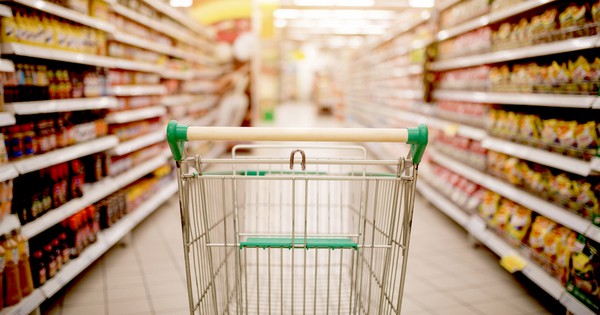How to grocery shop safely during COVID-19

Thankfully supermarkets are still open while we’re on coronavirus lockdown; but shopping now requires new protocols.
When we first started hearing about quarantines and lockdowns, many wondered if even supermarkets would be shuttered. Of course food is essential and the markets have remained open … and I have never been more grateful.
But with social distancing on turbo charge, it’s really hard to navigate the grocery store. Supermarkets are like obstacle courses; all narrow aisles and queues filled with people and shopping carts. But maintaining six feet of distance and other coronavirus precautions remain important, so here are some things to keep in mind to make shopping safe for yourself and others.
Only shop when you have to
When one is stuck inside all day, a jaunt to the market to pick something up feels like the most wonderful adventure. I found myself absolutely needing some emergency peanut butter the other day and thought, “Yes, I can just go get some!” But then I smacked myself out of my reverie and remembered that going to the store for not-exactly-essential items is a no-no. Every time someone leaves the house provides a potential for lapsed social distancing. And if everyone craving a single item went to the market to satisfy said craving, the markets would be filled with people, endangering the workers and those who are there for essentials.
Consider other alternatives
Think of shopping options aside from the supermarket. Local produce stores, co-ops, and ethnic markets may be less crowded, and would surely appreciate the business. Farmers markets in some urban areas may be even more crowded than the supermarket, and have fewer rules, but avoiding peak times may be safe. For more ideas about accessing food from local farms, see: Don’t forget your local farmers.
And maybe don’t go at all
Consider delivery, especially if you are in a high risk category. And if you have any COVID-19 symptoms, you are advised to stay home. If you get groceries delivered, have them left at your threshold, tip your delivery person electronically, follow disinfection guidance, and wash your hands when you’re done.
Make a list, organized by department
You want to minimize the time you spend in the market; the best way to do this is to make a list of what you need and organize it by aisle or department. This will prevent dawdling and backtracking.
Plan for substitutions
Because of supply challenges, the supermarket is not the cornucopia that it once may have been. For this reason, think in advance about back-ups so that you can make a quick substitution choice if your desired item is out. So, for instance, if the store is out of brown rice, what’s your next choice? White rice? Quinoa? Whole wheat pasta? Have a plan.
Use your pockets
Try to enter the market with as few things as possible. Leave your purse or wallet at home (or in the car), make your grocery list on paper not your phone, and put a tap-to-pay credit card in your pocket. I bring cash in a variety of bills so that I can pay with exact change. The fewer things you bring in to the store means the fewer things that you will need to disinfect when you get home.
Wear a face covering
Most health experts (and even non-experts) now urge people to cover their faces in public as a way to not spread the virus through asymptomatic carriers. In New York City, many supermarkets require a face covering to enter. Even if you aren’t concerned about getting the virus yourself, wear a mask for the sake and peace of mind of other shoppers and especially, for those working in the markets.
Gloves or hand sanitizer?
Some stores have sanitizing wipes at the entrance; grab one and can clean the shopping cart or basket handles. “Gloves will not be of much use here because if your gloves touch a contaminated product, they will just contaminate the next thing that is touched,” notes Good Housekeeping. Be cautious as you shop and as usual, try not to touch your face. If you have a small hand sanitizer, bring it in your pocket and use it after you you check out.
Be patient
If you are in an area that has occupancy limits in stores, there may very well be a line to enter. This is just the reality of things in our dystopian present – but at least it’s being done to protect us all. Be patient, and know that once you enter the store, it will be less annoying and crowded than usual.
Follow instructions
Different markets have different requests. Some have occupancy limits, others don’t; some require face coverings, but not all. Check-out lines may be mapped differently to maintain six feet of distance between customers. Some markets are even making aisles one way. I know we aren’t used to rigid rules in the supermarket, but for now, read the signs and follow the directions. And in markets that don’t have rules, be a good human and follow the protocols anyway.
Keep your distance
In narrow aisles, maintaining six feet of distance can be a challenge, but try your best. This means not coming up to the same spot as another shopper and hovering, and not paying attention to spacing in queues, for starters. If you see a crowded aisle, wait for it to open up. The average grocery cart is about three feet long, so imagine two carts between yourself and other shoppers.
If shopping with another, stay single file
It’s best to go alone, but if you do have a helper, do not move through the store adjacent to one another. Just like with COVID-19 sidewalk etiquette, it is harder to maintain six feet of distance for passing when you are passing two people side-by-side.
Lastly, be nice to the employees
Observe good pandemic shopping manners for the health of not only yourself, but really, think of the supermarket employees. These people are risking their health to show up for work and allow us the privilege of buying fresh food. Ensuring that you don’t get them sick and a genuine “thank you” is the least we can do in return.
For more on what to shop for, see: Pandemic pantry: a list for eating well with humble ingredients and Grocery shopping in a time of COVID-19.
Thankfully supermarkets are still open while we’re on coronavirus lockdown; but shopping now requires new protocols.







